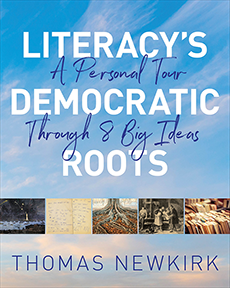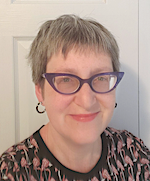The Democratic Roots Essential to Literacy
Literacy’s Democratic Roots: A Personal Tour Through 8 Big Ideas
By Thomas Newkirk
(Heinemann, 2023 – Learn more)
Reviewed by Laurie Miller Hornik
 Literacy and Democracy
Literacy and Democracy
Thomas Newkirk’s books are always deeply thoughtful, engaging, and full of warmth and humor, and this one is no exception. He brings his enormous experience and wisdom from writing and teaching over many decades to his exploration of the connections between literacy education and democracy.
Democracy is a broad concept, and Newkirk mostly uses it to refer to social equality and equal access. In his introduction he quotes his own tweet: “The house of literacy has a thousand doors. Our job is to help students find one that will let them in.” (xv) Newkirk’s democratic classroom is one in which every student can find their way into learning.

While the book is not a “how-to” book – there are no scripted lessons or lists of activities – it describes plenty of practices along the way and is inspiring for the teacher looking to expand their own practices to help each individual student thrive.
8 Big Ideas
For his “8 Big Ideas,” Newkirk chooses “Expressive Language,” “Funds of Knowledge,” “Transactional Model of Reading,” “The Writing Process,” “Translanguaging,” “Story,” “Multi (Multimodal, Multiliteracies, Multigenre),” and “Independent Reading.” Nestled near the middle is a “Credo” about his belief in “slow reading” and in the overall importance of reading.
Transactional Reading
One of my favorite chapters is “Transactional Reading.” While “transactional” has taken on a more negative connotation of late, Newkirk explains that here it refers to the transaction between “the reader’s intentions, interests, personal background, and pattern of attention” and the text itself (41). This is the approach that Newkirk honors, and he distinguishes it from the “Four Corners” approach, which asks readers to limit their analysis to what is on the page, bringing in no background information.
The latter is the approach made popular a century ago by the New Critics, and it is unfortunately present in the recent Common Core Standards. Newkirk points out that it is harder for students to feel engaged in reading when they are asked to leave themselves outside of the experience; and asking them to do so is a strange request, as it does not mimic how people read outside of school.
Like many other teachers, I have seen a downshift lately in students’ interest and ability to read, and I brought this concern with me to my reading of Newkirk’s book. I became very aware of how my own reading of this chapter at this moment would be different from anyone else’s because of where I am right now in my own teaching – and even different from what my own reading of it might be at another moment in time. It brought to mind Edmund Wilson’s famous quote, “No two persons ever read the same book.”
For reading to be rewarding for students, Newkirk asserts, students must be able to lose themselves in the book, to be in the “reading zone,” a term coined by Nancie Atwell (49). Near the end of this chapter, Newkirk poses this set of questions:
“So what are teachers to do? If the ideal state of reading is so immersive, an optimal experience of flow, isn’t any teaching strategy a form of disruption? Isn’t any request for reflection or analysis a distraction? How can we teach and still respect – even enhance – the reading experience? (50)
He follows this with suggestions and anecdotes while still letting the question itself remain present. It’s one we will all have to continue to grapple with.
The Writing Process
Of all the chapter headings, only “The Writing Process” begins with the word “The,” giving it a sense of heightened importance. And indeed, of all the shifts Newkirk describes in his book, how writing is taught in school might be one of the largest shifts of the last century. Back in the 1970s, Donald Graves led the research that culminated in writing being viewed and taught as a democratic process that everyone could and should participate in.
The Writing Process, as it is now taught in schools, involves pulling back the curtain to demystify all the steps writers go through, from finding or creating ideas to revising and polishing. This helps each student see writing as something they can do, as an activity they have access to.
Story
The later chapter “Story” is also focused mostly on writing. Newkirk critiques “the narrative-informational-argumentative trinity” that is commonly taught in schools (105). He makes the case that these are not three equivalent types of writing. Rather, “narrative” is a mode of writing while “argumentation” and “information” are purposes. The best argumentative and informational writing uses narrative to make its points. Narrative, also called story, is “the primary way we understand ourselves and our world” (119).
Newkirk does not fall into the trap of suggesting that the stories of our lives, what is often now called “lived experience,” replaces facts or data. Rather, he argues that story is needed for us to properly pay attention to and understand the information around us.
Independent and Free Reading
I’ll end this review – as Newkirk ends his book – by returning to the topic of reading. While Newkirk titles his final chapter “Independent Reading,” he calls the very last section of the chapter “Free Reading.” In it Newkirk quotes his own father, Maurice Newkirk, who wrote about the importance of “free reading” back in 1941, asserting “there is a place for free reading in the high school” (160).
At my middle school, most of us call the independent reading our students do “free reading.” Our nomenclature might have started because it’s shorter, catchier. We can say, “Take out your FRB” (pronounced “ferb”) or “Okay, it’s FRB time.”
These final pages of Newkirk’s book reminded me that “free” has somewhat different connotations from “independent.” “Free reading” connects the practice of choosing what you read, when you read, and how you read with freedom and democracy itself.
Laurie Miller Hornik is a K-8 educator with over 30 years of experience. Currently, she chairs the Middle School English Department and teaches seventh grade English at an independent school in NYC. Laurie is the author of two middle-grade humorous novels, The Secrets of Ms. Snickle’s Class (Clarion, 2001) and Zoo School (Clarion, 2004). She writes a weekly Substack of humorous essays called Sometimes Silly, Sometimes Ridiculous and creates mixed media collages, which she shows and sells locally and on Etsy.






























